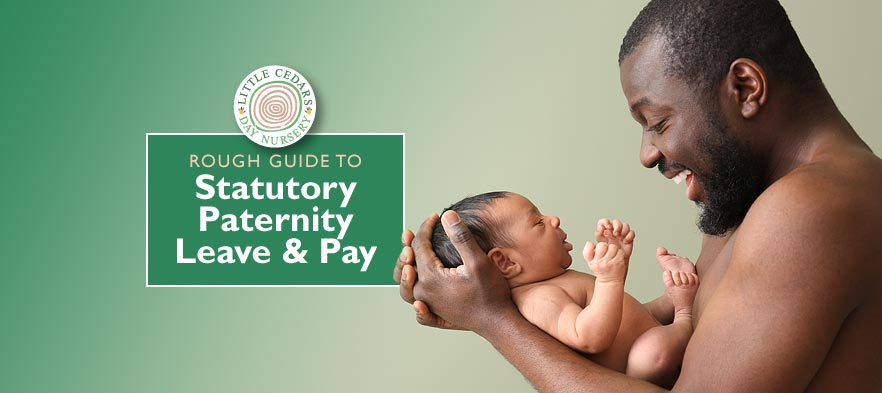
 Following up from our Rough Guide to Statutory Maternity Leave & Pay (for mothers), we follow up with a similar guide for the father (or partner of the mother, including in same-sex relationships). As you’ll see, some of the rules are quite different …
Following up from our Rough Guide to Statutory Maternity Leave & Pay (for mothers), we follow up with a similar guide for the father (or partner of the mother, including in same-sex relationships). As you’ll see, some of the rules are quite different …
Statutory Paternity Leave
An eligible father/partner of the mother can take just one or two weeks of Statutory Paternity Leave off work when their partner has a baby — so, significantly less than the mother. The length of time they’re entitled to does not increase if twins, triplets or more are born — it remains at 1 or 2 weeks total. It’s also worth noting that the paternity leave needs to be taken in one go, not split up into smaller chunks of time.
We should also clarify what counts as a week. This is however many days they work in an average week in their employment.
Timing
 The father, or partner of the mother, must give their employer at least 15 weeks’ advance notice that they wish to take Statutory Paternity Leave. This can be imprecise, however, given that they won’t be 100% certain which day the child(ren) will be born. If they later change the proposed date, employers must be given at least 28 days (4 weeks) notice of the change, made in writing if requested by the employer.
The father, or partner of the mother, must give their employer at least 15 weeks’ advance notice that they wish to take Statutory Paternity Leave. This can be imprecise, however, given that they won’t be 100% certain which day the child(ren) will be born. If they later change the proposed date, employers must be given at least 28 days (4 weeks) notice of the change, made in writing if requested by the employer.
Statutory Paternity Leave must end no later than 8 weeks after the date of the birth (or due date if born early) and must not start until the baby is actually born. Please note that different rules apply for those who are adopting and we do not comprehensively cover those in this article.
Eligibility
To be eligible for Statutory Paternity Leave, the person must be taking time off to look after the child and needs to be:
 the child’s father, or
the child’s father, or- the mother’s husband or partner (including if same-sex), or
- the adopter of the child, or
- if the baby is born through surrogacy, the intended parent.
In addition, the person:
- must be an employee of a company (with an official employment contract);
- must give the correct advance notice (see ‘Timing’ section above);
- must have been working for their employer continuously for 26 or more weeks prior to the 15th week before the baby is due* (N.B. different rules apply for those who are adopting);
- must not have already taken Shared Parental Leave (‘SPL’);
- if adopting, must not have already taken paid time off to attend adoption appointments.
Statutory Paternity Pay
 To be eligible for Statutory Paternity Pay, a person needs to:
To be eligible for Statutory Paternity Pay, a person needs to:
- earn £120 or more each week, before tax;
- give the correct advance notice to their employer (see ‘Timing’ section above);
- be employed by them right up to the date of the birth;
- have been working for them continuously for 26 or more weeks prior to the 15th week before the baby is due* (N.B. different rules apply for those who are adopting).
* The 15th week before the baby is due is is known as the Qualifying Week.
Those whose income has dropped below an average of £120 per week due to being on furlough during the pandemic may still be eligible.
How Much Do They Get?
An eligible father/partner of the mother will receive the lower of £151.97, or 90% of their average gross weekly earnings, per week.  The payments are made through their wages by the employer after deducting any tax and National Insurance if due. (Figures correct at September 2021).
The payments are made through their wages by the employer after deducting any tax and National Insurance if due. (Figures correct at September 2021).
Making a Claim
Fathers/partners of the mother can use the same online tool as mothers to check what they’re entitled to. Start here.
Protected Employment Rights
As with mothers, a number of statutory employment rights for the father/partner of the mother are still protected under law. These include rights to possible pay rises, accruing of holiday leave and of returning to work after completion of the paternity leave. Eligible working parents are able to claim several weeks of unpaid parental leave under certain conditions. If met, they are eligible to take 18 weeks off (unpaid, but per child) before their child is 18. Follow the bold link earlier in this paragraph for more information, via our separate post.
Watch this space because we’ll cover the rules around Shared Parental Leave and more in separate, future guides.
An Outstanding Nursery in Streatham SW16
 This guide was brought to you by the team at Little Cedars Nursery in Streatham. For parents searching for the best nursery for their child in Streatham, Little Cedars represents a great choice. We offer outstanding weekday childcare in Streatham, also being convenient for those requiring a childcare nursery near Tooting, Furzedown, Streatham Common, Streatham Hill, Streatham Park, Balham, Norbury or Colliers Wood. To book a tour, ask a question or register for a nursery place for your child, please use one of the following options:
This guide was brought to you by the team at Little Cedars Nursery in Streatham. For parents searching for the best nursery for their child in Streatham, Little Cedars represents a great choice. We offer outstanding weekday childcare in Streatham, also being convenient for those requiring a childcare nursery near Tooting, Furzedown, Streatham Common, Streatham Hill, Streatham Park, Balham, Norbury or Colliers Wood. To book a tour, ask a question or register for a nursery place for your child, please use one of the following options:


 Being let loose with coloured paints, art materials and creative opportunities is sure to bring a smile to their faces and a sense of enormous fun, creativity and discovery. No doubt too; they’ll be proud to show others their creations!
Being let loose with coloured paints, art materials and creative opportunities is sure to bring a smile to their faces and a sense of enormous fun, creativity and discovery. No doubt too; they’ll be proud to show others their creations! As well as being enormous fun, messy play allows children to express themselves in unbounded creative ways. That’s important. Self-expression and creativity will help children to gain a sense of achievement and, through this subtle way, a greater sense of self-worth and confidence.
As well as being enormous fun, messy play allows children to express themselves in unbounded creative ways. That’s important. Self-expression and creativity will help children to gain a sense of achievement and, through this subtle way, a greater sense of self-worth and confidence. Hand-eye coordination will also benefit, of course.
Hand-eye coordination will also benefit, of course. We fully understand the many benefits of messy play at Little Cedars Nursery, of course. Indeed, it’s part of the curriculum. Under-fives are encouraged to learn through messy play using an enormous wealth of resources, equipment and materials at the setting. That’s both indoors and in our outside play areas. From paint and paper indoors to sandpits and water play outside, toddlers and preschoolers have a wonderful time with messy play at Little Cedars, all in a safe, structured, fun and educational environment.
We fully understand the many benefits of messy play at Little Cedars Nursery, of course. Indeed, it’s part of the curriculum. Under-fives are encouraged to learn through messy play using an enormous wealth of resources, equipment and materials at the setting. That’s both indoors and in our outside play areas. From paint and paper indoors to sandpits and water play outside, toddlers and preschoolers have a wonderful time with messy play at Little Cedars, all in a safe, structured, fun and educational environment.